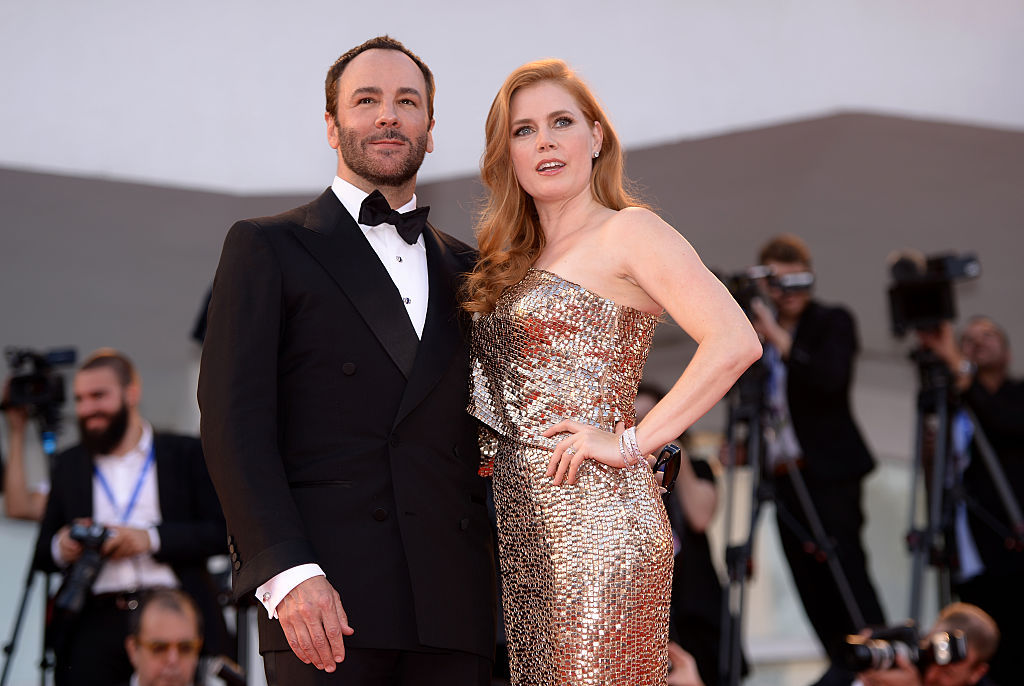
Tom Ford’s second movie, Nocturnal Animals, based on the novel Tony and Susan by Austin Right, premiered on September 2 at this year’s Venice film festival to an audience pregnant with anticipation.
The film opens with a confrontational image. A macabre burlesque of older women gyrates, their faces leer at the camera. Scant accessories provide the outline of invisible majorette costumes, falling glitter establishes full trash credibility and the audience is almost subsumed in the swirling dancing of naked flesh. Perhaps a Parody of Tales of the Unexpected, this is a wake up call for any viewer who thought they were going to slip into something easy and stylish from the godfather of the Gucci tuxedo—and a million miles away from the beautiful people we normally associate with Tom Ford.
Once it’s clear that this bizarre and awkward performance is actually contained within the smug irony of an art work, normality returns, the audience relaxes, and it feels even safer when we realize that the art work is being installed into a world that is perhaps all too familiar—Susan’s Gallery. And thus, one of the key themes of the movie is established; difficult subjects are explored at a distance of once removed.
Susan, brilliantly portrayed by Amy Adams, is beautiful and every bit West Coast Contemporary art. She has the clothes, the gallery, the art, a handsome but far away husband. On the surface, her life is complete, and yet in the great tradition of film noir it is clear that something is missing and she is wistful. When she confides her ennui to her her friend Carlos (Martin Sheen), he replies, perhaps ominously “Believe me, our world is a lot less painful than the real world.”
Nocturnal Animals. ©Merrick Morton Universal Pictures International
Lo and behold, the missing element soon arrives by US mail, inscribed with a dedication to Susan. It is the unpublished novel of her former husband, Edward—someone she has not seen in almost 20 years.
Alone for the weekend, Susan puts on her glasses and begins to read. Through the pages of the manuscript, we travel to the next strand of narrative, the terrifying visceral world of Nocturnal Animals. The juxtaposition between sophisticated-superficial LA and the gritty, unstable, and at times terrifying West Texas could not be clearer. (In fact, Ford moved the location of the novel’s narrative from Maine to West Texas, the place where he grew up, as it was the only place in America where it would be possible to be stranded without a mobile phone signal, giving the story, published in 1993, plausibility in 2016).
If the LA scenes give Ford a blank canvas to design an idealized lifestyle and make gentle mock of where he lives now, the Texan section of the movie is full of action, passion, and tension. Both strands are cinematographically stunning thanks to the work of Steven McGravey. There are echoes of Truman Capote’s In Cold Blood in the rawness of the Texan scenes. Aron Taylor Jonstone gives a phenomenal performance as Ray, the leader of the bad boy gang, and there’s a stomach churning inevitability about the whole thing.
Susan becomes convinced the story laid out in the manuscript is about them; that Ted (Jake Gyllenhaal) is her ex-husband, and Laura Hastings (Isla fisher) is in fact her. The lines between the two narratives are well managed, but the influence of the novel on Susan’s reality is becoming palpable. Back in Texas, the arrival of Bobby Andes—the archetypal Texan law man—brilliantly portrayed by Michael Shannon, moves the story along and revenge begins to dominate the movie.
-
Nocturnal Animals. ©Merrick Morton Universal Pictures International
It is Susan’s interpretation of the novel that creates a third and final dimension. Memories of her marriage appear and bubble up. There is a stunning cameo from Laura Linney as Susan’s mom portraying the cliché that you will turn into your mother—in this case, a caricature of a republican in whopping pearls, riddled with prejudice and soaked in booze.
As the stories come together it is Susan’s own memories with Edward—and her appropriation of what she has understood about herself from the text—that dominates the present. It’s interesting to note that Lewis Austin, the author of Susan and Ted and an academic, passionately believed that the reader was just as responsible for the meaning of the novel as the writer, something that Ford has clearly taken to heart in his brilliant screen play.
Nocturnal Animals. ©Merrick Morton Universal Pictures International
Nocturnal Creatures is a visual feast. It looks beautiful and for the art and art world scenes alone it is well worth watching. Like all good art works, this film works very well on the surface, but, in order to get the full message from Ford—the message about art mimicking reality and reality mimicking art, loyalty, past love, what might have been, and life coming full circle—it is the kind of film that you are going to have to watch again.
Comparison with Ford’s debut film A Single Man (2009) is inevitable; the fact that Colin Firth was a prominent guest at the premiere was no coincidence. But Nocturnal Creatures is a much more complicated and sophisticated movie than the incredibly beautiful A Single Man—hotly anticipated when it came out, and loaded with promise. Ford’s second feature is a fully fledged movie with huge ambition, for awards and box office success. This is a film that is going to have to stand on its own two feet in the real world if Ford is going to become the brilliant film maker he appears to have the ability to be.